Diversity Through the Times: The Past 30 Years of Dramas
In the vast realm of great dramas, there are none as recognized as those awarded the Academy Award for Best Picture. Since 1929, the award has been dubbed to the film of the year that has proven to be exceptional in every regard, from writing and directing to acting. The majority of these films have been dramas, and though they have been recognized as the “best”, they have had a historically low representation of diversity, both in terms of race and gender. In looking across the span of movies awarded Best Picture, we can begin to see the gradual movement towards recognizing the work of minorities, a shift that continues on into the future.
How Diverse are Oscar Winning Dramas?
For each film included, the cast/crew roles included in the data analysis include director, writer, lead actors, producers, and executive producers. The data is also formatted into the racial categories of White, Black, Hispanic, Asian, and Middle Eastern, as well as the gender categories of Male and Female. This was all sorted into 2 separate pie charts for each movie analyzed.
How Diverse is Schindler’s List (1993)?
Centering on the atrocities of the Holocaust and the historical account of one man who attempts to make as large a difference as he can, the film Schindler’s List dives into deeper themes of responsibility and morality. Released in 1993 with Spielberg’s name as director, the movie went on to receive critical acclaim, earning a 98% rating from critics and a 97% rating from viewers on Rotten Tomatoes. Within its leadership, 100% of the cast/crew roles of Schindler’s List were occupied by White members. Even in its gender diversity, approximately 86% of the cast/crew is made up of male members, with a remaining 14% of female members.
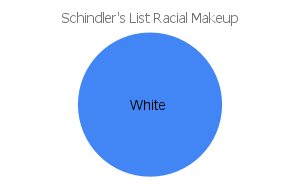
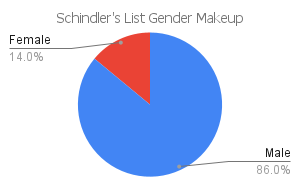
How Diverse is Shakespeare in Love (1998)?
One of the few romantic comedies to make its way to the Academy Awards, Shakespeare in Love (1998) defied all expectations when it won Best Picture over war film Saving Private Ryan (1998). Based upon historical narrative, the film received a 92% rating from critics and an 80% rating from viewers, a high rating despite its essentially non-existent diversity. Though released 5 years after Schindler’s List, Shakespeare in Love displays the same racial makeup as the film; 100% of its leadership roles went to White individuals. Though this number demonstrates little change towards diversity, the film does display a gender distribution where 27% of its cast/crew is made up of female members, with a remaining 73% of male members.


How Diverse is The Return of the King (2003)?
The Lord of the Rings: The Return of the King (2003) remains one of the few winning films within a saga to make its way up to the Oscars stage. Critically acclaimed, the last chapter of J.R.R. Tolkien’s tale of Middle-earth moved audiences enough to earn a 93% rating from Rotten Tomatoes critics and an 86% rating from viewers, which carried it on to awards ceremonies. Though the film is based upon the fictional world of Middle-earth, its racial diversity does not display great distribution: 100% of the film’s cast/crew members are White. The same goes for its gender diversity: only 15% of its cast/crew are female, while 85% are male.
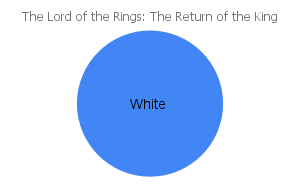
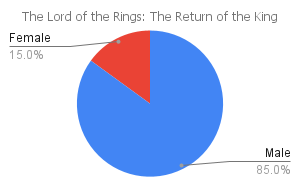
How Diverse is Slumdog Millionaire (2008)?
Slumdog Millionaire (2008) begins a different path for diversity in the Oscars, despite being separated by the same 5 years from The Lord of the Rings: The Return of the King. Reviewed as one of the best depictions of poverty and perseverance, the movie received a 91% rating from critics and a 90% rating from viewers. With its high ratings and first look at upcoming actor Dev Patel, the movie displays its prowess both within its storytelling and its cast/crew diversity. The leadership of the film is made up of 71% White individuals and 29% Asian individuals. The same numbers feature within its gender composition: 71% of the cast/crew are male, with only 29% being female.
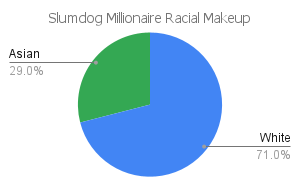
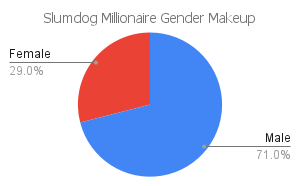
How Diverse is 12 Years a Slave (2013)?
12 Years a Slave (2013) continues the change of the Academy towards recognizing diverse stories. Following the life of free man turned slave Solomon Northup, its brutal depiction of the horrors of slavery earned the film a 95% rating from Rotten Tomatoes critics and a 90% rating from viewers. Just by its racial makeup, the film displays the shift in the Academy’s prioritization of diversity: 25% of the film’s leadership is Black, while the other 75% is White, a drastic change from past distributions of Best Picture films. Even in its gender diversity, 12 Years a Slave has a similar distribution: 25% of its cast/crew are female, with a remaining 75% male cast/crew, a distribution that signifies change.
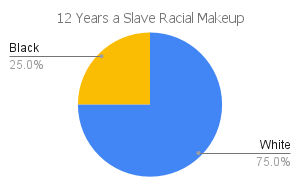
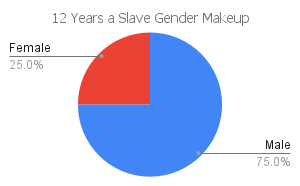
How Diverse is The Green Book (2018)?
One of the most recent Best Picture winners, 2018’s Green Book, demonstrates this ongoing trend towards both telling and recognizing diverse stories. The film, which received a 77% rating from Rotten Tomatoes critics and a 91% rating from viewers, focuses on the bonds forged in the face of prejudice. The film has a racial distribution of 23% Black cast/crew members and 77% White cast/crew members. But its gender makeup of 8% female cast/crew and a 92% male cast/crew falls flat.
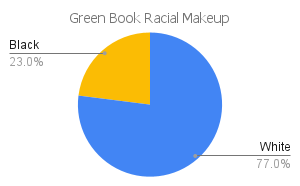
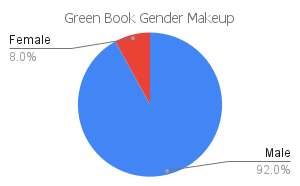
Have Dramas Improved When it comes to Diversity?
Overall, the diversity of dramas over the years has changed drastically, especially those that earn the Academy Award for Best Picture. Though there are multiple sources for this shift, ranging from a movement pushing for greater diversity within the film industry to general expansion of diversity within stories, the answer remains clear: the face of modern drama has changed in both the stories told and those who tell them over the past 30 years.
Featured Image by Walt Disney Television, used under the Attribution-NoDerivs 2.0 Generic Creative Commons License



